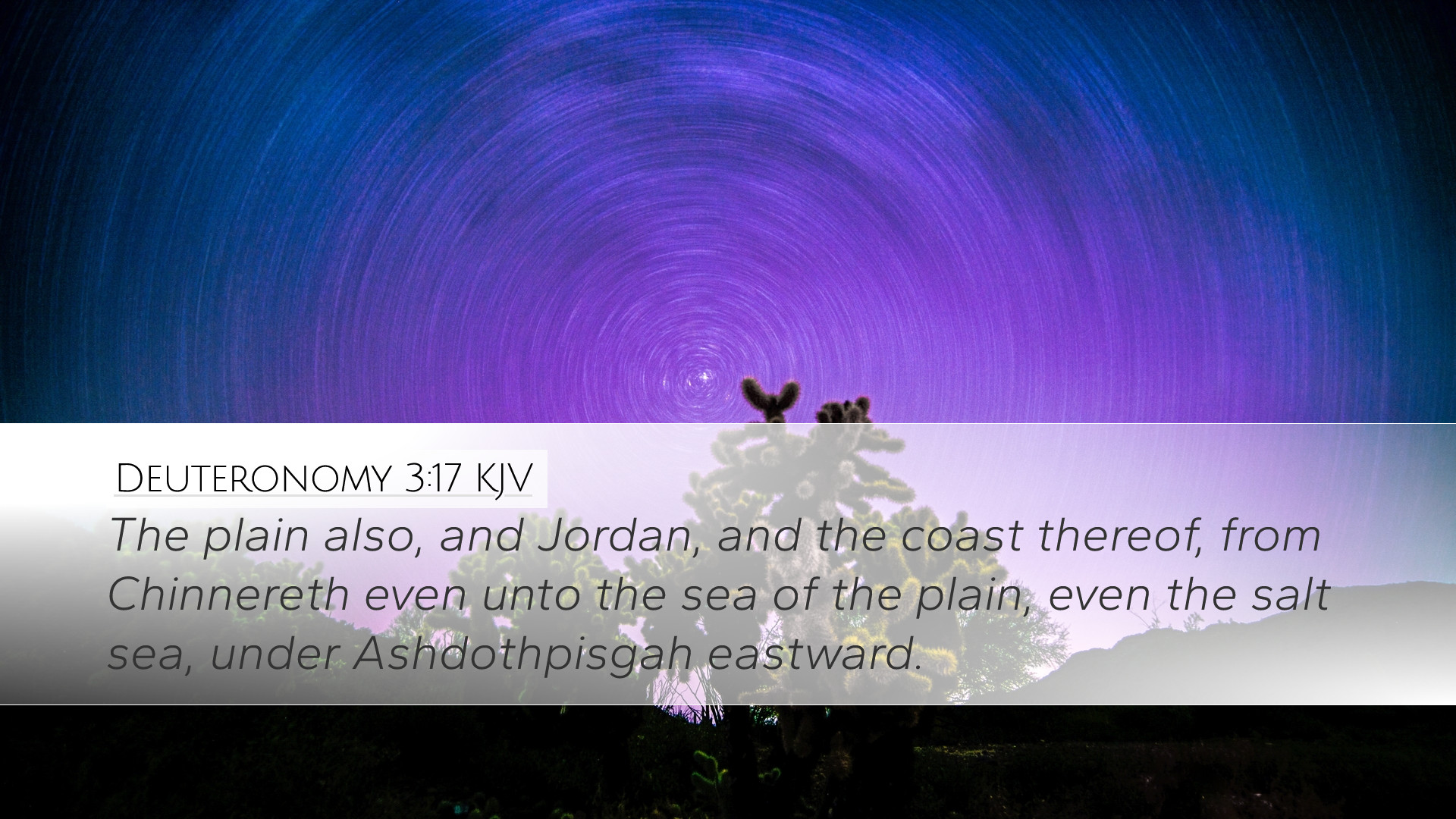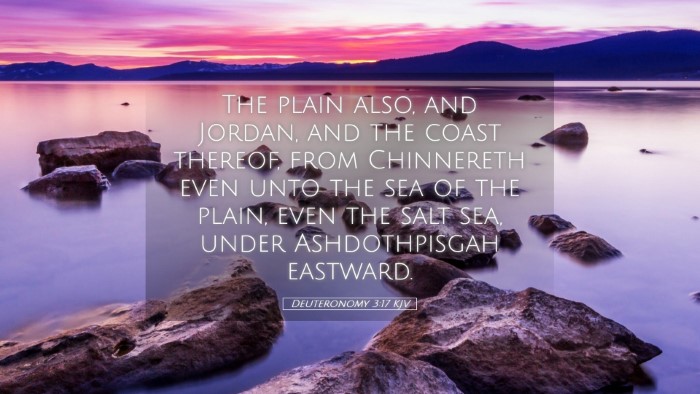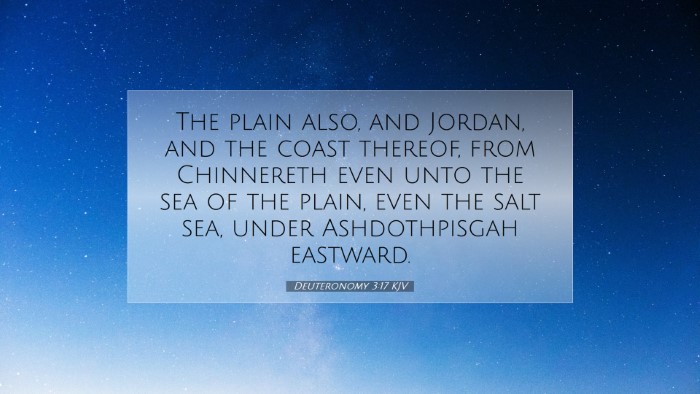Commentary on Deuteronomy 3:17
Verse: "The plain also, and Jordan, and the border of it, from Chinnereth even unto the sea of the plain, which is the salt sea, under Ashdoth-pisgah eastward."
Overview
Deuteronomy 3:17 is a pivotal verse that encompasses geographic and symbolic significance in the journey of the Israelites as they approach the Promised Land. The mention of various locations provides insight into the boundaries set for the tribes as they prepare to enter Canaan. This passage can be studied through the lenses of geography, theology, and history, making it a rich subject for pastors, theologians, and students alike.
Geographical Context
This verse details specific locations within the territories Israel would inhabit, namely:
- The plain: Refers to the flat expanses of land suitable for cultivation and settlement.
- Jordan: The river that is significant both as a physical boundary and a marker of divine promise. It is the river that the Israelites would cross to enter the land flowing with milk and honey.
- Chinnereth: Also known as the Sea of Galilee, this lake is notable for its agricultural abundance and historical importance in the life of Jesus.
- The Salt Sea: Commonly referred to as the Dead Sea, this body of water signifies desolation yet forms a boundary making it clear that certain areas are defined for the Israelites.
- Ashdoth-pisgah: The mention of Pisgah indicates specific high places that provide a divine perspective and are associated with prophetic visions.
Theological Significance
The geography of Deuteronomy 3:17 extends beyond mere cartography to the larger narrative of God’s covenant with Israel. Each location mentioned serves a purpose in highlighting God's faithfulness and the inheritance of His people:
- Covenant Promise: The borders signify God’s promise made to Abraham, Isaac, and Jacob about the land that will belong to their descendants.
- Divine Guidance: The delineation of territory reflects not just physical guidance but spiritual direction. God is leading His people to a place where they can thrive under His law.
- Contrast of Life and Death: The Salt Sea represents death and desolation in contrast to the lushness of the land promised to them, illustrating the stark difference between following God's path and turning away.
- Prophetic Foreshadowing: The high places like Ashdoth-pisgah allow for moments of revelation, suggesting that higher expectations and spiritual insights are a part of the journey into God’s promise.
Historical Context
The historical backdrop surrounding Deuteronomy points to a critical moment for the Israelites. They are on the brink of entering a land that has been promised through generations. Commentaries note that this provision of land is laden with themes of deliverance:
- Exodus and Wilderness: The Israelites’ journey through Egypt, into the wilderness, and now toward the Promised Land underscores a transformative process orchestrated by divine will.
- Faithfulness in Leadership: Under the leadership of Moses, the people are reminded of their journey’s significance, including the promise of each geographical landmark.
- Reminder of Trials: The mention of past struggles serves to build faith—reminding the Israelites of God’s continued support in their trials as they transition to a place of rest.
Commentary Insights
The exploration of the verse through public domain commentaries provides deeper understanding:
- Matthew Henry: Emphasizes how the boundaries instilled a sense of identity and purpose among the Israelites, reminding them that their existence is rooted in God’s plan.
- Albert Barnes: Points out that the geographic references serve not only as historical points but as spiritual markers for understanding God’s provision in their lives.
- Adam Clarke: Illustrates that each location, particularly the high places, is a reminder of aspiration and the need to keep focused on divine revelation.
Practical Applications
For contemporary readers and leaders, Deuteronomy 3:17’s insights can be applied to various aspects of faith and practice:
- Leadership: Recognize the importance of guiding congregations towards their spiritual inheritance while remembering God’s past provision.
- Community: Understand that physical places can carry emotional and spiritual weight; they can serve as reminders of God's faithfulness.
- Reflection: Regularly reflect on personal journey markers that signify spiritual growth and transformation.
- Faith Challenges: Embrace geographic and metaphorical “wilderness experiences” as opportunities for trust-building in God’s promises.
Conclusion
In conclusion, Deuteronomy 3:17 encapsulates not only a logistical explanation of the land but serves as a profound reminder of the spiritual journey of the Israelites. It calls to mind the faithfulness of God and the importance of recognizing divine boundaries within our journeys. The geographical markers become spiritual applications, offering lessons in leadership, faith, and the fulfilling of God's promises—continuously relevant to pastors, theologians, and all believers today.


